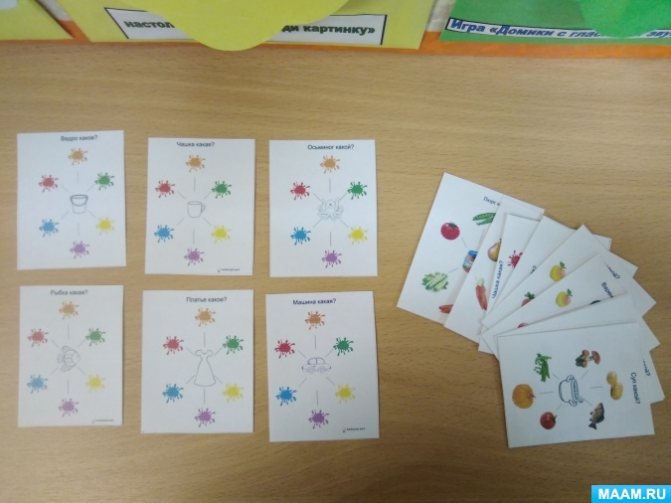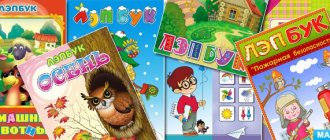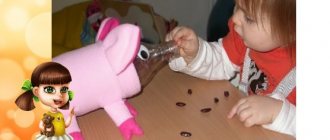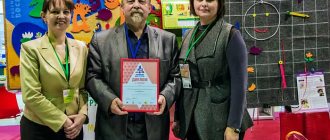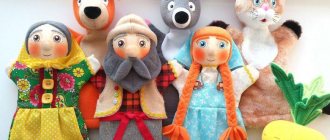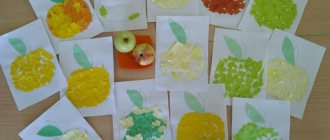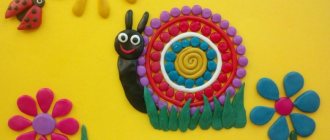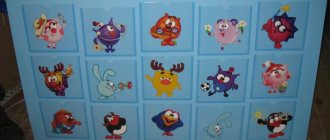What is a lapbook for speech development for preschoolers
A laptop for speech development in a preparatory group is a modern teaching aid for children in the form of an interactive folder. With its help, you can conduct both individual work and subgroup classes. A modern approach to organizing work on speech development makes it possible to interest children who attend kindergarten aged 3 to 6 years. Thus, the teacher’s work becomes more productive.
Description of the term lapbook
Note! Creating a lapbook helps consolidate and systematize the material studied, and looking at the folder allows you to refresh your memory of the material covered. As a rule, lapbook can be used both individually and in a group lesson.
The “Rechevichok” laptop consists of the following sections:
- “Syllabic daisy” for learning to compose syllables;
- plot pictures for composing stories;
- puzzles;
- shading to prepare the hand for writing;
- card index of antonyms;
- puzzles;
- pure talk;
- game "Sound Tracks" for the development of sound pronunciation;
- Tongue Twisters;
- poems about letters;
- game “Make a letter from sticks”;
- game “Make syllables and words”;
- game for developing air flow “Blow a butterfly off a flower.”
How does a laptop affect speech development?
According to experts, the laptop has a beneficial effect on the development of speech for children in preschool age. Children in the older and younger groups begin to pronounce words correctly. Sound differentiation occurs. Next, the teacher suggests looking at various illustrations and plot pictures that serve to compose stories.
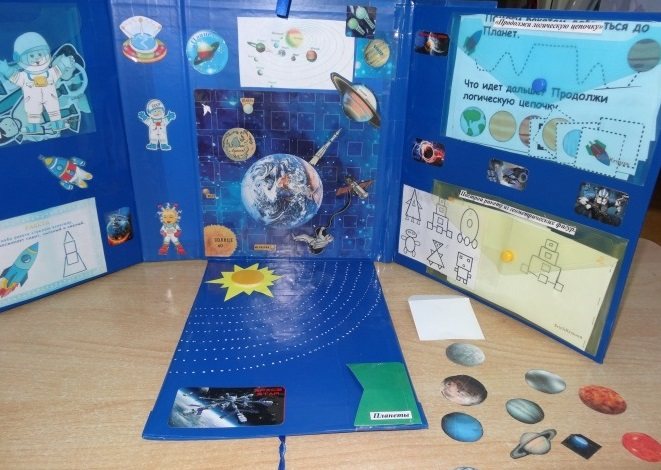
What effect does lapbook have on speech development?
Important! While completing assignments, the teacher does gymnastics with the children. Proper breathing plays an important role in speech development. Light movements contribute to the development of visual perception, attention, memory, and self-control.
Ready-made templates for printing
Anyone can download ready-made templates completely free of charge by following this link. For example, you can download educational tasks on the theme “Spring”. They present the following topics:
- “What fruits grow in spring”? — cards for studying seasonal plants.
- A pocket with riddles on the theme of spring.
- “Growing a plant” - we observe the growth of the plant, entering the results into a table.
- “Weather calendar” - children keep a weather diary.
- Template “Spring Flower Garden” - children study spring flowers.
- “Who from what?” — cards with animals are provided.
- “Spring Primer” is an accordion book for creativity.
- Notebook “Signs of Spring” - kids study spring phenomena.
- Mini-book “Poets about Spring” - learn by heart poems on the theme of spring.
- Fairy tale based on the painting by A.K. Savrasov “The rooks have arrived.”
Games for the development and formation of coherent speech in preschoolers

Lapbook “Speechman” - video review https://www.youtube.com/watch?v=e5hsshqLYNQ
Author: Tatyana Belan
Based on your numerous requests, we have created a lapbook for speech development!
This manual, aimed at developing coherent speech in children on a given topic, presents vivid illustrative and textual material, interesting tasks, each of which involves enriching vocabulary and mastering the grammatical side of speech. The manual will be useful and effective for the joint work of children and adults (parents and teachers) at home or in preschool educational institutions, in speech therapy classes and speech development classes.
Make a lapbook “Rechevichok” using our templates and use it with pleasure!
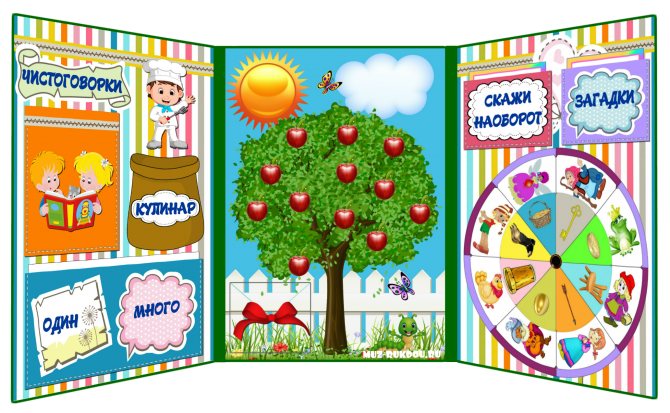
Lapbook format - A4 (electronic version), for downloading, printing and assembling the layout yourself. Number of sheets for color printing - 27 pcs. File type - compressed archive (pictures in JPEG format) File size - 57 MB Genre: working in Photoshop
thick for printing !
General description Front side: 1. Lapbook cover 2. Left side part - DI “Make a story using pictures” (9 cards + pocket) 3. Central part - A4 sheet with the alphabet Internal part of the laptop:
1. The left side part of the “Pure Tale” is a leaf-page book with pictures and text (12 pages) DI “Cooking” in the form of a book with illustrations (12 pages) DI “One-Many” (9 double cards + pocket)
2. Central part Game exercise for the development of speech breathing “Miracle Tree” (envelope + small elements 12 pcs.)
3. Right side part of the Circles of Lull “Which fairy tale is this object from?” (2 larger and smaller circles) DI “Say the opposite” (14 cards + pocket) Speech riddles “Say the word” (12 cards)
Basic backgrounds for the laptop Description of educational games
You can see instructions for assembling the layout HERE
- The order is delivered automatically within a few minutes after payment to your email address specified when placing the order.
- If the letter is not in your inbox, please check your spam folder.
- When filling out the order form, please make sure your e-mail address is correct!
COST OF ELECTRONIC VERSION — 280 rub.
After clicking the button, you will be taken to the product page in Robo.market
![]()
via a secure protocol. You can choose any convenient payment method.
Before purchasing, please read the terms of supply of materials and answers to frequently asked questions
How to place and pay for an order
Protected by copyright law.
Copying, transfer to third parties, posting on the Internet,
and commercial use of site materials is strictly PROHIBITED.
How to make a lapbook with your own hands in kindergarten for speech development
You can make a laptop with your own hands using appropriate items.
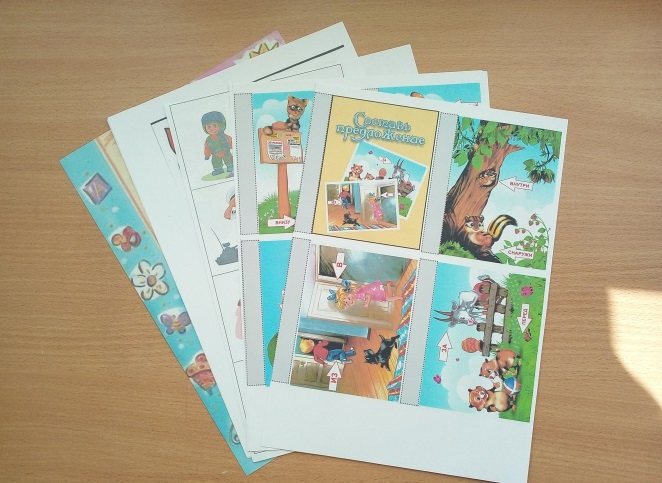
How to make your own lapbook
Didactic game “Make a story from a picture”
Goal: expand and activate children's vocabulary; develop the ability to use adjectives, verbs, adverbs, prepositions when communicating; encourage word creation.
“Tell a story” (using a mnemonic table)
Goal: to develop interest in the literary genre - the fairy tale, the ability to tell a fairy tale, sometimes using symbols, to develop memory, thinking, attention, creative activity, and speech skills.
Didactic game “Find the sound”
Goal: to develop auditory perception, articulatory apparatus, phonemic hearing.
Note! To develop the ability to distinguish by ear and name words that have a certain sound in the word.
Didactic game “Make a letter” (like “Cut pictures”).
Goal: to develop fine motor skills, attention, memory.
Finger gymnastics (complexes).
Goal: develop communication skills; form correct sound pronunciation; ability to speak clearly; develop fine motor skills, coordination of movements, memory, attention; the ability to coordinate movements with speech.
Didactic game “Come up with a word.”
Goal: to develop the ability to come up with words with letters at the beginning, middle, end of a word, phonemic awareness, auditory perception.
Didactic game “From letter to syllable.”
Goal: to develop the ability to compose syllables. As an option, invite children to add letters to form a word (ХО - chorus).
Pure talk
Goal: to cultivate the sound culture of speech, to develop correct sound pronunciation.

Photo of homemade lapbook
The Internet contains thematic interactive folders on environmental topics related to nature. For example, how to clean the planet from garbage or bodies of water. By downloading a lapbook on the topic “Take care of nature,” it will indicate what you can and cannot do in nature.
Note! Children can learn environmental proverbs.
Lapbook for the middle group for speech development
Lapbook for the middle group on speech development is an excellent assistant for educators. With the help of this material, children will learn to pronounce words correctly, speak slowly and clearly, carefully look at illustrations, compose complex sentences and enrich their vocabulary. In addition, fantasy and imagination are formed.
Typically, a lapbook includes the following sections:
- Poems that help you process sounds.
- Puzzles.
The main goal is to develop the ability to solve riddles.
Important! Thanks to tongue twisters, the child develops correct pronunciation and improves diction. This way, you can pronounce difficult words quickly and clearly.
Templates of speech therapy characteristics for children of different levels for PMPC
Pure tongues form and improve phonemic hearing and lexical and grammatical categories.
The game “What for what” (Find a pair) is being considered. During the activities, the guys compare individual objects. The basic things are highlighted. This game is aimed at developing attention, thinking, and memory.
Lapbook on speech development for senior and preparatory groups
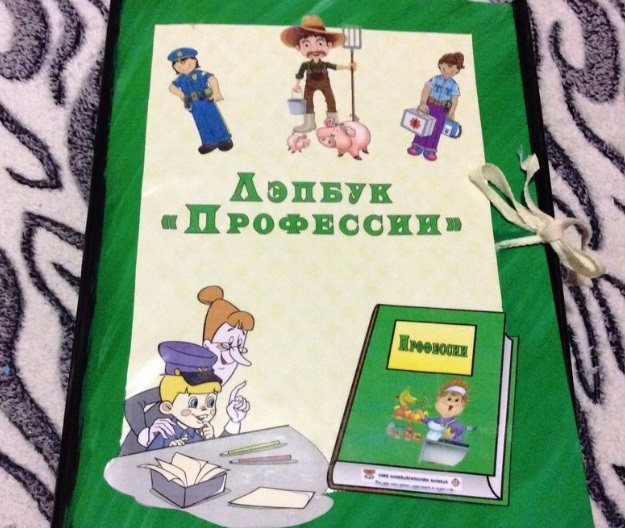
Lapbook for speech development for senior/preparatory groups
Lapbook “Streamlet - little speech”
This lapbook is used for speech development in the middle group according to the Federal State Educational Standards method, prepared by educators.
Note! The main task is the formation of speech activity and improvement of auditory perception.
Application: in the lesson “Speech development”, “Teaching literacy” in individual work with a child and a subgroup of children.
Contents: 7 didactic games for speech development.
“Make sentences based on the picture”
Goal: to activate the dictionary, teach children to determine the number and order of words in a sentence.
"Tell me a story"
Goal: development of coherent speech, ability to compose a story according to a diagram (mnemonic tables).
"One, many"
Goal: Agreement of nouns with numerals (1,2,5, etc.).
“Name the words by their first letters”
Goal: improve phonemic hearing, sound perception.
“Find words starting with the given letter”
Goal: to develop children’s ability to determine the sequence and place of sounds in words, perform sound analysis of words, and develop phonemic hearing.
"Stories with Pictures"
Goal: to improve children’s ability to read stories based on pictures with sequentially developing events.
"Coloring"
Goal: to teach children to look at drawings with interest, to complete tasks independently, to develop children’s imagination and creative abilities.
Lapbook as a means of developing the sound culture of speech in preschoolers
- October 10, 2016
Fast distance online competitions
Competition “Lapbook as a learning tool in the conditions of the Federal State Educational Standard”
“Time spent interacting with a child rewards us adults with deep childlike affection.”
Explanatory note
Relevance.
In connection with the implementation of the Federal State Educational Standard for preschool education, every teacher is looking for new approaches and ideas in their teaching activities. An important aspect of modern Russian education is “teaching oneself to learn.” The teacher is faced with the task of teaching the child to set goals and objectives, find ways to solve them, and most importantly, find the necessary information to solve the question posed among a huge variety of sources of information.
Everyone knows that we remember better what is interesting to us, what was emotionally charged. How to make sure that the material covered remains in the child’s memory, so that he can learn to use the knowledge that he has received on a certain topic, so that he wants to independently expand his horizons on this issue. One of the ways to achieve this goal of education at this stage of development of society, we find the use of a laptop in the educational process. It can be used both in kindergarten and at home.
A laptop is a portfolio or a collection of small books with pockets and windows that make it possible to place information in the form of drawings, small texts, in any form and on any topic. This is a book that is assembled by a teacher and children, glued together its individual parts into a single whole, and creatively designed using all sorts of colors and shapes. Thus, we can say that a lapbook is a collective image of a poster, book and handouts that teaches you to think and act creatively within the framework of a given topic, expanding not only your horizons, but also developing the skills necessary to overcome difficulties and solve the problem.
Problem.
From observations of children in the preparatory group, we found out that their speech is not perfectly formed and is difficult to understand for those around them: they do not pronounce certain sounds, change syllables or skip them completely, and do not place the emphasis in words correctly. Fearing ridicule, children begin to feel embarrassed about their mistakes and avoid communicating with their peers. Children become unsure of their abilities, which leads to negative consequences.
Based on the results of monitoring the speech development of children, it was revealed that 72% have not developed a sound culture of speech, and only 28% have normal phonemic hearing.
In the process of questioning parents on the topic “Speech development of children of senior preschool age,” it was found that:
- 36% have no idea whether their child’s speech development corresponds to the age norm;
- 55% work with their child to improve his speech through such forms as reading fiction, attending classes with a speech therapist, following the recommendations of teachers, and playing theatrical scenes at home.
Taking into account the importance of the problem on this issue and the monitoring results, together with our colleagues we developed a didactic manual (lapbook) “Entertaining alphabet learning” on the education of the sound culture of speech through didactic games and exercises (NGO “Speech Development”, direction “Teaching Literacy”).
Goal: from
creation of a lapbook “Entertaining ABC studies” on the formation of sound culture of speech in children of senior preschool age.
Tasks:
- To analyze the educational program of the preschool educational institution and the monitoring results of children in the OO “Speech Development”.
- Select games and exercises to develop phonemic hearing and speech sound culture.
- To create a unified educational space for preschool educational institutions and families of pupils on issues of speech development of preschool children.
Lapbook structure
The central place in the lapbook is occupied by the “Sound Drum” and “Letter Ball”.
The “sound drum” is a circle with sectors on which tasks are proposed (“Soft - hard”, “Stress”, “Sounds in a word”, “Division into syllables”, “Sound analysis of a word”). Its main goal is the formation of sound analytical-synthetic activity as a prerequisite for learning to read and write.
“Letterball” - a snare drum, is a circle with sectors on which game tasks with a letter are proposed (“Make a letter”, “Assemble puzzles”, “Shade the letter”, “Circle the dots”, “Lay out a letter from counting sticks”) , the purpose of which is to develop fine motor skills in children of senior preschool age and memorize letters visually.
The side tabs contain material for tasks on the reels.
For children who can read, the following tasks are presented: “Read It” and “Waterfall”. There are also game tasks: “Find the letter”, “Rebuses”, “Dominoes”, “Which letter is hidden”, “Complete the letter”, “Turn the letters into a drawing”.
If the child’s performance decreases, then the lapbook contains tasks that help relieve stress in children:
- “Sing Together”, where children can listen to a song in the soundtrack, perform it themselves with a backing track, or play around with it.
- "Articulation gymnastics."
Advantages of a laptop:
- can be used in individual work with a child to develop speech activity.
- is one of the forms of organizing joint activities of a child and parents.
- actively used by children in independent activities.
- is a set of tasks and exercises on a specific topic.
- is a diagnostic tool for the teacher.
Results:
- 67% of children have developed phonemic hearing;
- 53% of children developed normal coherent speech;
- children actively use lapbooks in independent activities, in pairs and subgroups;
- The survey process revealed that the level of parents’ knowledge about the development of their child’s speech has increased.
Perspective
- Involve a speech therapist teacher in enriching the laptop with tasks and exercises to develop the sound culture of speech.
- Develop lapbooks for children of primary, secondary and senior groups.
Bibliography:
1. Babaeva T.I., Gogoberidze A.G., Mikhailova Z.A.. “Childhood” program. St. Petersburg, 2011
2. Volina V.V., Artist. Rudakovskaya L.M. – M.: Education, 1994. – 400 p.
3. Zhurova L.E.,. Durova N.V. Educational and training complex "Teaching preschool children to read and write." – M.:, 2014. – 192 p.
4. Popova D.A., The best games for a child’s development and preparation for school. From 3 – 6 years. – St. Petersburg: Peter, 2010. – 240 p.
5. Internet resources: - https://ta-vi-ka.blogspot.ca/2014/02/lapbook-winter.html#sthash.efg4O48G.dpuf
Authors: Podkovskaya Natalya Sergeevna, teacher of the first qualification category, Buzmakova Iraida Leonidovna, teacher, Malkova Nadezhda Gennadievna, teacher of the highest qualification category, MBDOU "Kindergarten No. 8", Vereshchagino.
Lapbook on the formation of sound culture of speech
Creative tasks, cut material, stickers, riddles in a folder
Each preschooler can design his own folder. To do this, you need to use scissors, colored pencils, felt-tip pens, and multi-colored pens. Children's boundless imagination will also come in handy in this matter.
Note! The idea behind making a lapbook is that you can play with it for a long time.
Children like this approach to education much more.
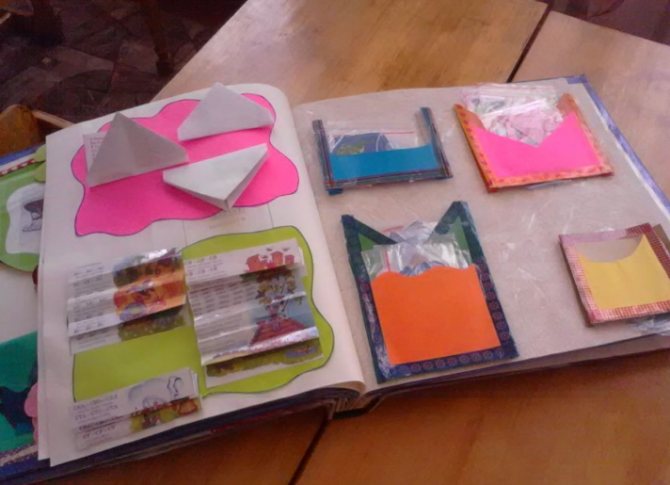
What materials are used to complete creative tasks?
Initially, you need to cut out the pockets and stick them on the markings. They can be colored using stickers. Next, you will have to stick the achievement scale on the side of the folder. Cards should be laid out with tasks in pockets glued to the base, while coloring the lapbook, and then decorating it with stickers.
Speech therapy tongue twisters on colored cards
The speech therapist conducts a master class and offers to study developing cards with tongue twisters. During the study of tongue twisters, pictures are colored with colored pencils. By pronouncing tongue twisters, the child learns to pronounce difficult sounds and words correctly.
Note! This challenging lesson can be turned into a fun game. This is why speech therapists recommend that parents and educators buy a developmental set of game cards.
Creating a lapbook will help consolidate and systematize the material studied, and looking at the folder in the future will allow you to quickly refresh your memory of the topics covered.
Lapbook “Developing Speech” for senior preschool age
Elena Kuznetsova
Lapbook “Developing Speech” for senior preschool age
Author: Teacher of MBDOU kindergarten No. 469 Kuznetsova Elena Stanislavovna
The laptop has educational , cognitive and educational significance, as it awakens the child’s creative abilities, his brightest feelings and thoughts. I hope that this lapbook will provide children with many precious minutes of useful and interesting communication.
TASKS:
1. Pronounce all sounds correctly;
2. Speak slowly, expressively, maintaining the conversation;
3. Learn to carefully examine a picture, an object, compose a story based on a model;
4. Make coherent sentences based on the picture from 5-6 sentences;
5. Learn to listen and understand the content of sayings and proverbs;
6. Enrich vocabulary, use prepositions in speech;
7. Develop visual attention , thinking, memory, coherent speech , fantasy, imagination.
LAPTOP “ SPEECH DEVELOPMENT ”
includes the following sections:
1. "Opposites"
Goal: To teach children to select words that have opposite meanings and pronounce them correctly. Development of memory , logical thinking, vocabulary.
Brief course of the game: Children are given pictures depicting objects that have opposite sign values. It is proposed to find the opposite property for a given picture and name the value of the attribute.
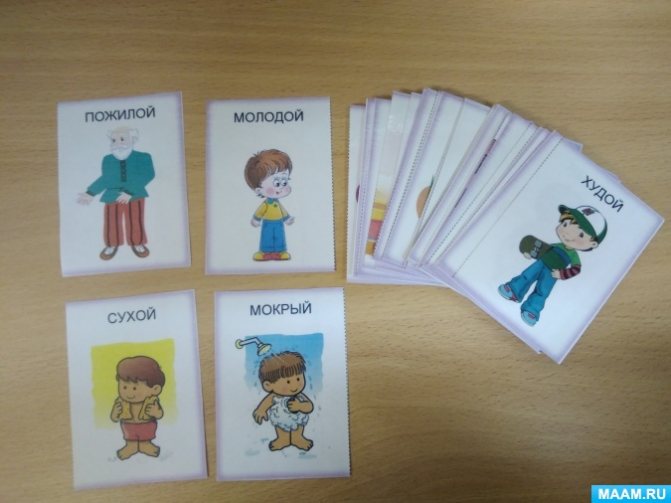
2. "Collect the word"
Puzzle cards “Collect the word”
is an educational and
developmental game with which your child will easily and quickly remember letters, learn to add simple syllables and words, read, and also expand their vocabulary.
The game promotes the development of speech , attention, thinking, fine motor skills and imagination. The set is intended both for children just beginning to learn the alphabet, and for those who already know the letters and have minimal syllable reading skills.

3. "Find the picture"
Purpose of the game: to teach children to identify the vowel sound at the beginning of a word, to learn the vowel letters A, O, U, I, E.
Assignment: on the children’s tables are cards with six pictures and a set of cards with vowel sounds (A, U, O, I, E)
Cards with letters and pictures are included (you must first print and cut them)
.
It is necessary to determine what the first sound is in the name of the picture and close the picture with the corresponding vowel letter.
A-nanas is the first sound of A, O-slick is the first sound of O, ...
- Which pictures did you cover with the letter A? The letter O? etc.
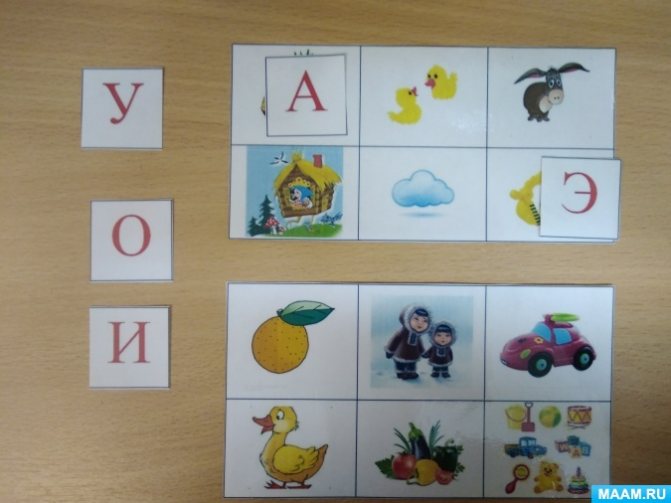
4. "Three Letter Words"
Rules of the game: you show the card with the side on which the letters are written, and he must “guess”
, which is drawn on the back. You can complete this task by reading the word that matches the image. If the child reads the word correctly, he will be able to turn the card over and see the picture. The child takes the cards read correctly, and those that are read incorrectly remain with the leader.
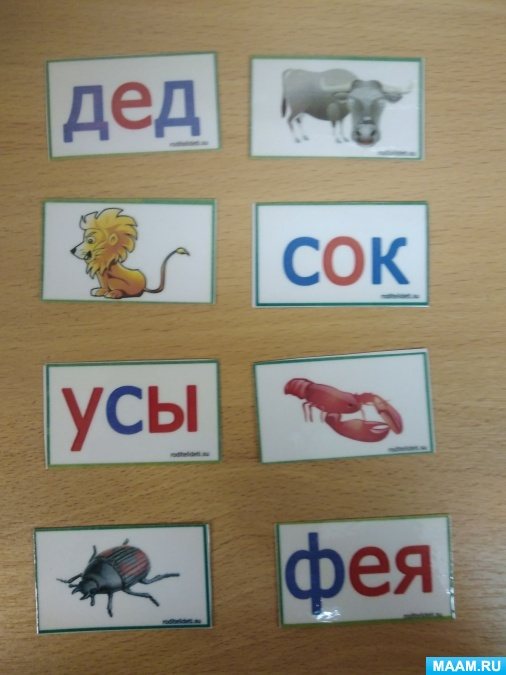
5. "Settled into houses"
In the houses "he"
,
“she”
,
“they”
,
“it”
live words of masculine, feminine, neuter singular and plural.
To “settle”
words into houses is to intuitively determine their gender and number without naming the terms.
Purpose of the game:
• Train to determine the gender of nouns and their number (without naming terms)
.
Game objectives:
• Practice the correct use of singular and plural 3rd person nouns.
• Practice the correct use of 3rd person pronouns.
• Enrich speech with nouns and pronouns.
• Promote the development of speech , attention, thinking.
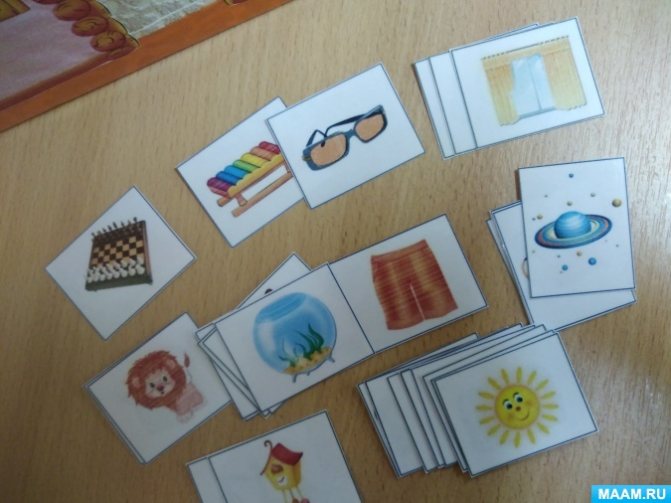
6. Pictures - actions “Who is doing what?”
Tasks:
— clarify, expand and activate the child’s vocabulary;
- develop coherent speech - teach the child to correctly combine words in a sentence, use different parts of speech, compose sentences of varying complexity, then short stories;
- learn to answer questions and ask them yourself;
- develop logical thinking , attention, observation;
— develop imagination;
- enrich the child’s social experience.
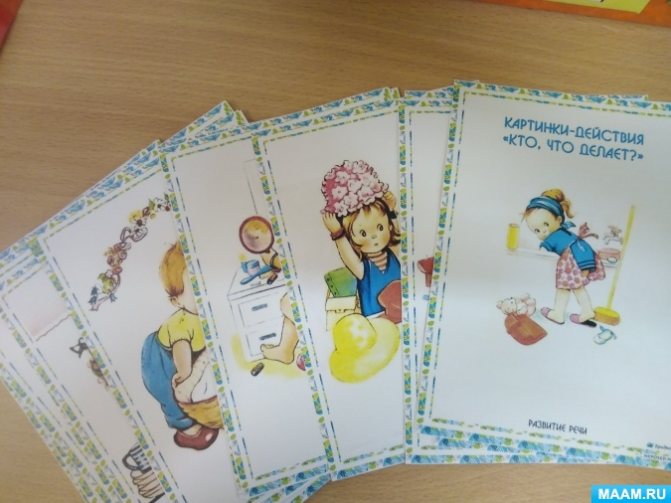
7. "Proverbs"
Goal: to teach children to express the meaning of a proverb in their own words.
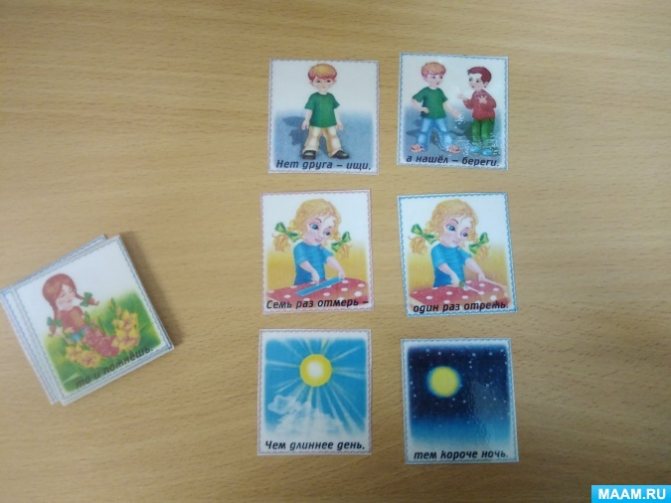
8. "Pure talk"
Pure tongue twisters and tongue twisters are useful exercises for the development
How to work on them:
- read the tongue twister and show an illustration for it;
- explain the meaning of complex words;
- say a tongue twister, clapping the rhythm with your palms;
- say the tongue twister three times at a fast pace;
- take the ball and, rhythmically tossing and catching it with both hands, say a tongue twister.
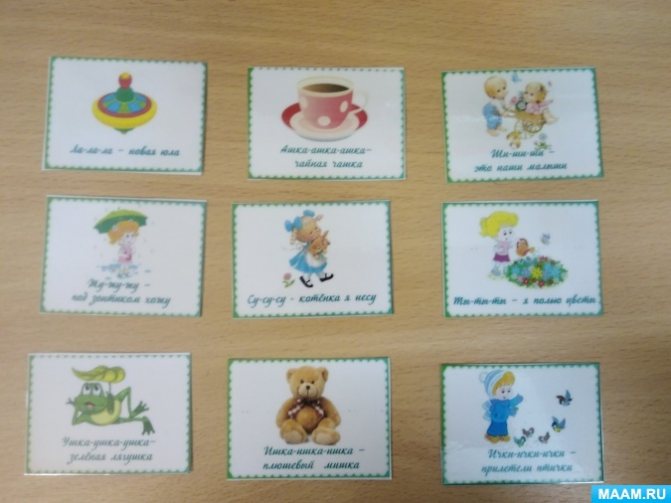
9. Didactic game “Tell me”
Compiling descriptive stories using mnemonic diagrams
Learning to compose descriptive stories is very important for the development of a child , because the ability to accurately, concisely and figuratively describe an object is a condition for improving speech and thinking, and facilitates the process of exchanging information.

10. Game “Houses with vowel sounds”
Children have house cards with letters and cut cards with pictures for adults. Assignment: listen carefully, if you hear a word that begins with a letter from your card, say it. Whoever fills in the empty spaces in the house on their card the fastest wins.
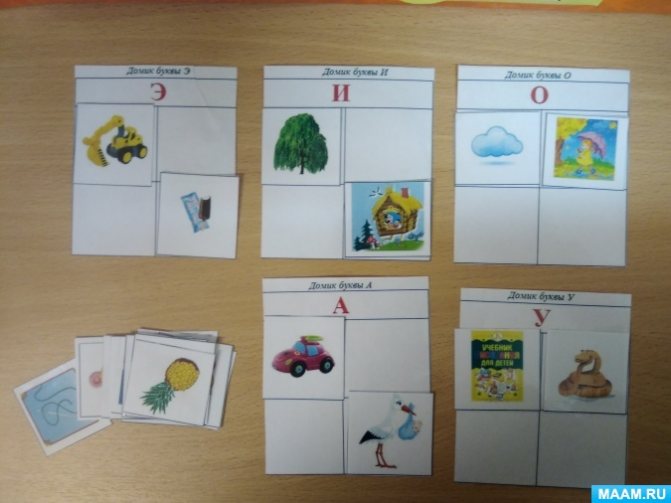
11. Game “First and last sound in a word”
Goal: developing the ability to identify the first and last sounds in a word.
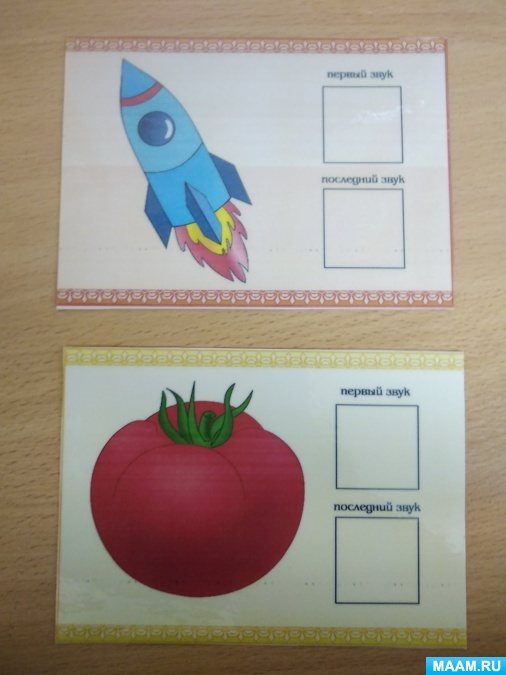
12. Speech game “Aquarium”
Goal: To consolidate the ability to determine the place of sound in a word.
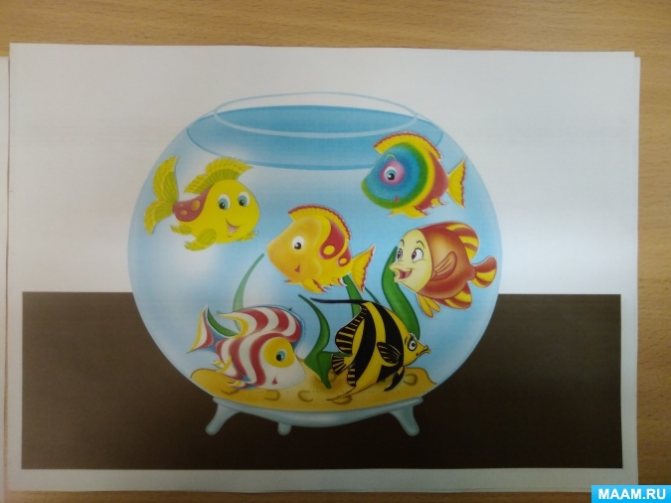
13. Games for the development of speech breathing .
Proper breathing is the basis of sound speech. It ensures normal voice and sound production and maintains fluency of speech. Since speech is carried out while exhaling, the correct pronunciation of many sounds and the smoothness of the speech flow depend on the strength, direction and duration of the air stream. Insufficient differentiation of oral and nasal breathing can lead to unclear pronunciation of sounds and their confusion. When working on correcting sound pronunciation, the speech therapist should draw the child’s attention to the participation of the air stream in sound formation and correct speech breathing.

14. Match the letter to the word.
Goal: to train children in identifying the first sound in a word. To consolidate children's knowledge of the sounds and letters they have learned.
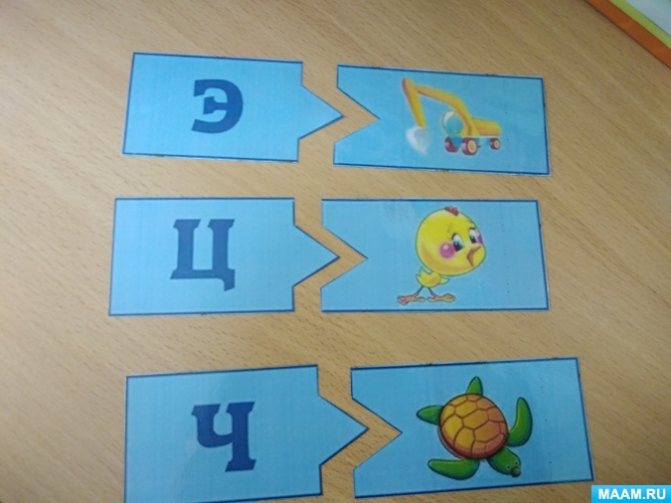
15. Speech game “Which one?” Which? Which?"
Goal: learn to select adjectives that correspond to a given card.
Tasks:
Developmental:
-develop the ability to select adjectives,
-develop children's speech,
-develop attention.
